


Echoes: The Best of Pink Floyd
Several Species of Rare Film Clips Gathered Together in a DVD Anthology and Grooving With a Pict
Throw your thoughts back many years
Witness the man who raves at The Wall
Recycled RoIOs
The 1970 and 1971 BBC sessions
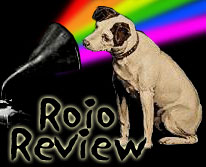 As the topic of this issue of Spare Bricks is Recycled Floyd, I will take a look at recycled RoIOs. The most recycled of all Pink Floyd shows is undoubtedly their 1971 BBC session, closely followed by the 1970 BBC session. Some of these are excellent works, while others are badly made, deliberately mislabeled pieces of junk.
As the topic of this issue of Spare Bricks is Recycled Floyd, I will take a look at recycled RoIOs. The most recycled of all Pink Floyd shows is undoubtedly their 1971 BBC session, closely followed by the 1970 BBC session. Some of these are excellent works, while others are badly made, deliberately mislabeled pieces of junk.
Of course, if you are reading this article, you most likely are a collector of Floyd RoIOs, and in that case chances are high that somewhere in your collection you indeed have at least one of these recordings. So here is a (short and seriously incomplete) look at the various Pink Floyd RoIOs covering the BBC sessions.
The Echoes FAQ has this to say about the Pink Floyd BBC sessions (version 4.0, section 5, question 10)
What was played on the BBC sessions?
In 1970 and 1971 Pink Floyd played at John Peel's BBC show. The exact dates and performance details for these shows have been shrouded in confusion for years, and has been given wrongly in numerous publications (including the BBC - In Session Tonight and earlier versions of this document).
These shows include some of the best and most popular "live" performances of early Floyd material.
16 July, 1970. BBC's Paris Theatre, London UK.
Sounds of the Seventies: John Peel Show, BBC 1 Radio.
Recorded on the 16th
Broadcasted on 19july70 at 4:00 PM and
rebroadcasted on 22jul70 at 6:00 PM
"The Embryo" - 10:30
"Fat Old Sun" - 5:00
"Green Is The Colour"/"Careful with that Axe, Eugene" - 11:30
"If" - 4:30
"Atom Heart Mother" - 26:00
Total time: 60:00
This is the only live performance of "If" by Pink Floyd, with Roger on acoustic guitar and Rick on bass and organ simultaneously (Roger did perform it numerous times on his solo tours). "Atom Heart Mother" was performed with the accompaniment of The Philip Jones Brass Ensemble.
 From top to bottom, Meddled, Mooed Music, and BBC Archives 1970-1971 |
The Fat Old Sun is missing from the BBC transcription discs, and is only available because Floyd fans recorded the radio show all those years ago. The quality of this track is therefore less on the Mooed Music ROIO. Most common RoIOs omit this song altogether.
30 September, 1971. BBC's Paris Theatre, London UK.
Recording for the John Peel Show, BBC 1 Radio
Recorded on the 12th of October
Broadcast at 10:00 pm
"Embryo" - 10:30
"Blues" - 5:00
"Fat Old Sun" - 15:00
"One of These Days" - 8:00
"Echoes" - 28:00
Total time: 68:00
Note: "The John Peel Show" was only 55 minutes long. "Embryo" and "Blues" were never broadcast in the UK. (see Note) They were only aired on WNEW-FM, New York City, USA sometime in 1971. This WNEW portion was broadcast only once, unfortunately, and features the station's call sign ("This is WNEW...") in the middle of "Embryo". As a result of this all versions of "Embryo" in circulation either have a rough (or very smooth) edit, or contain the call sign. The 1971 and 1970 shows are rebroadcast nearly every year in the USA on the "King Biscuit Flour Hour." However, it is a combination version of the two shows and is incomplete.
Meddled (HRV CDR 001)
Mooed (HRV CDR 005)
BBC Archives 1970-1971) (HRV CDR 007)
Even the excellent folks at Harvested Records have recycled these BBC sessions, and three of their releases cover these shows. Each of these shows has gone through various incarnations. Meddled in its final incarnation is based on the original BBC mono master tapes of the 1971 show. This is by far the best sounding of all the 1971 BBC RoIOs I've owned, and is certainly my favorite.
Mooed Music in its early incarnations contained the (then) very rare live performance of "Fat Old Sun" (which was missing from the transcription disks) in a version that had been taped of the radio all those years ago. The final incarnation of this disk is also based on the original BBC mono masters.
The BBC Archives set is a 2-disc RoIO which contains the definitive stereo versions of these recordings.
Libest Spacement Monitor (The Swingin' Pig)
You'll have to dig out your copy of the Echoes FAQ, or research your Floydian lore to find out where that tile came from. Until the Harvested releases, this was probably the best BBC 1970 RoIO in circulation
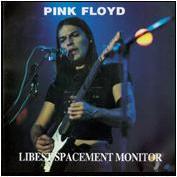 Libest Spacement Monitor |
The Last BBC Session 1971:
Another excellent sounding, complete one. Almost as good sounding as Meddler, but in stereo. Until Harvested released their definitive BBC sessions this was probably the best sounding stereo version of the 1971 shows I had heard.
The Hall of Shame
There are so many bad RoIOs that contain some or all of the BBC shows (either cut up, as filler, and/or clearly mislabeled) that the hall of shame should overflow. I'll limit myself to naming just a few I have had the (dis)pleasure of listening to.
Bytes of the Talisman
As with many RoIOs, this one is misdated. It is listed as 16sep70 whereas it should have been 16jul70. It is mastered from vinyl, so some pops and clicks are audible.
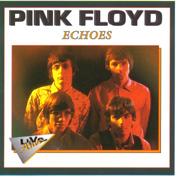 Despite the Syd-era cover image, Echoes is yet another (bad) version of the 1971 BBC show. |
Echoes
Apart from the fact that there are a zillion RoIOs with that title (and pretty much all of them suck, so it is a blessing in disguise) the main reason to despise this RoIO is that its a crappy cut-and-paste job. There are three tracks from the 1971 BBC sessions and one track from the San Diego Golden Hall concert (17oct71).
Early Tour Years
This was my first RoIO with the (as of then) complete BBC sessions ("Fat Old Sun", "One of These Days", and "Echoes" from 1971, and five tracks from 1970). The CDs are ordered incorrectly (the 1971 show is disc 1) and sound bad (though compared with the other shows I had then, the sound was excellent), but they included a little bit of the DJ talk.
BBC transcription discs
These were vinyl bootlegs that were made to look enough like the real thing to fool the casual buyer. Twenty years ago these already sold for outrageous prices. With luck, what you bought was a fake that was at least made from the real thing, but usually these were just created from the radio broadcasts.
Tour 73
A vinyl RoIO that claimed to be from the French tour in 1973, it consists of "Echoes", "Embryo", and "Fat Old Sun" (all from 1971). Its sole saving grace is that it indeed includes the 1971 "Embryo" which was (at that time) relatively hard to get.
From Oblivion
This is a brilliantly-packaged CD set, with better sound and more complete then any other recording of the San Diego Golden Hall show (17oct71). Its too bad, then, that they had the urge to splice some BBC tracks in there with the San Diego show and not state so on the packaging. Otherwise From Oblivion would have ranked as one of my all time must-have RoIOs.
Echoes: The Best of Pink Floyd
The Spare Bricks Retro-Review
Editor's Note: In Spare Bricks issue #6, we began the tradition of reviewing new Floyd releases well after they are released, and framing the review in a less traditional way--the Spare Bricks Retro-Review. In retro-reviews, we will attempt to examine how any new release fits into the overall scheme of Pink Floyd's history, where it ranks relative to other Floyd albums, and whether it's a worthy (or worthless) addition to the Pink Floyd catalog.
This may come as a shock to some people, but I don't own every Pink Floyd title.
Oh, I have all of the regular studio albums, and the live albums, and the solo projects. But the Floyd titles I haven't found the motivation to purchase are Relics, Works, and until very recently, Echoes: The Best of Pink Floyd.
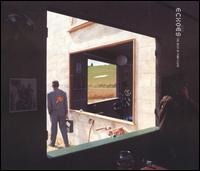 Echoes - The Best of Pink Floyd |
It doesn't take a rocket scientist to figure out what these titles have in common: they are all compilation albums. (I did purchase a vinyl copy of A Collection of Great Dance Songs about a year ago in a moment of weakness, largely because it cost about a dollar.) Not that I have anything about compilation albums, whether labeled 'greatest hits' or 'best of' collections. I have a good two dozen compilation albums for artists that I enjoy casually--Rush, David Bowie, the Doors, Supertramp, and so on. I don't like any of these artists enough to collect all of their records, but I like enough of their songs that it's nice to have all of my favorites gathered together on one disc. And occasionally, I will enjoy a compilation enough to start seeking out the band's regular albums (which is exactly what the artist and record company want: to capture the interest--and income--of untapped markets).
For the sake of argument, I want to differentiate between a 'greatest hits' compilation and a 'best of'. There is little doubt that sometimes an artist's greatest achievements fail to become hits, and often enough the 'hits' aren't nearly as interesting or as compelling as some of the more obscure tracks. In my mind, artists should try to decide which target they are going to shoot for when producing a compilation. Do you want to include the hits, all the hits, and nothing but the hits? Or do you want to release a more all-encompassing 'best of' that can include the hits as well as some obscure tracks that fans and critics recognize as 'essential'?
Sometimes the desire to be all things to all people makes for a very disappointing compilation. How many times have you bought a group's 'best of' album, only to discover that there are two or three familiar songs that are missing... and at the same time, there are a number of dreary, unfamiliar tracks included instead? Or perhaps you have encountered one of the other compilation pitfalls: new songs recorded especially for the compilation (which, by definition, are not 'hits', and are unlikely, statistically speaking, to be considered the 'best' of the artist's work), or previously unreleased material, or a 'rare' live version or remix of a familiar hit. These are all common ploys used by artists and record companies to get the die-hard fans--who already own all of the regular releases--to add the compilation to their collections.
Well, when it comes to Pink Floyd, I--like most of you--already own all of the 'regular' albums. I know them inside and out. I don't really need any of the compilations. Even the standard ploys don't really entice me: I don't need the 'previously unreleased' track ("When the Tigers Broke Free") on Echoes, just as I don't need the previously unreleased track ("Embryo") on Works.
So where does the Echoes compilation fit? What need does it fill? It can't really be called a 'greatest hits' collection. It is missing far too many staples of classic rock radio ("Brain Damage"/"Eclipse", "Have a Cigar", "Welcome to the Machine", "Run Like Hell", "Young Lust", "On the Turning Away", et cetera). Any casual fan that knows the Floyd only by their radio exposure and who buys Echoes looking to have all of the familiar songs in one collection is bound to be disappointed.
There are also far too many non-hits included. Songs like "Sheep", "Jugband Blues", "Bike", and "Set the Controls for the Heart of the Sun" may please the hard-core fans and the bandmembers themselves, but the average casual Floyd fan hasn't even heard of Syd Barrett, let alone want to hear four of his songs, 'best of' or not.
'But,' I hear you saying, 'Echoes doesn't claim to be a collection of the Floyd's Greatest Hits. It clearly says "The Best of Pink Floyd" right there on the box'. So it does. Then I'll ask you this: is the song selection truly representative of the Floyd's 'best' work? "Marooned" is a lovely song, but is it truly among their 'best'? How about "The Happiest Days of Our Lives"? "Keep Talking"? "The Fletcher Memorial Home"? "Jugband Blues"?
I would suggest that the band envisioned Echoes as neither a 'greatest hits' collection nor a 'best of' regardless of the title. Echoes was conceived as a retrospective of the band's career, from their first single and the heady days of the London Undergroud, through the superstardom of the mid-to-late-1970s, to the sometimes-disappointing and always-controversial recordings of the 1980s and '90s.
Viewed in this light, the tracklist makes a lot of sense. There are five songs by Syd Barrett, including the group's first single ("Arnold Layne") and its first real hit ("See Emily Play"). There are only three tracks from the period between Syd's departure and the superstar/'glory years', but these include "Echoes" (considered by many fans to be the group's single greatest song) and the radio staple "One of These Days". There are a whopping twelve cuts from the fertile period between 1973's The Dark Side of the Moon and 1979's The Wall. Six songs come from the post-Wall years--one with Roger Waters, and five without him.

Sounds like a nice, evenly-balanced affair, doesn't it? Well, consider this: Syd Barrett recorded with Pink Floyd for a little less than a year, but roughly one-fifth of the songs on this compilation were written by him. The five years between Syd's ouster and the release of Dark Side saw unprecedented experimentation and growth, and is widely regarded as a favorite era by many serious fans. But much of that development took place onstage and did not translate well onto the studio albums. More importantly, the band members have all expressed a lot of embarrassment toward the records of this period, so the fact that these records are under-represented is hardly surprising. Still, only two of the six albums released between 1968 and 1972 are represented at all.
Even when you get to the period of the band's career that produced essentially all of the 'greatest hits' that the casual fan will be looking for, there are still a few surprises. Not only are there quite a few big hits missing, but some that were included leave you scratching your head a bit. "The Happiest Days of Our Lives", for example, is little more than an intro to "Another Brick in the Wall (part 2)", even within the context of The Wall. "Sheep" is a great song, and one for which David Gilmour has expressed some affection. But if you are only going to choose one track to represent Animals, why not make it "Pigs (Three Different Ones)"? It is only minimally longer and has the added benefit of getting some airplay now and then, so it will be more familiar to the casual fans. (You have to assume that someone within the Floyd considers "Sheep" to be a 'better' song than "Dogs" or "Pigs"--which is interesting considering that Waters has performed both of these in solo tours, while "Sheep" hasn't been performed since 1977.)
"When the Tigers Broke Free" seems to have been included as an opportunity to plug Echoes as containing previously-unreleased material. Only it wasn't previously-unreleased; it had been released as a single in 1982. Except that this is a slightly different version. Or something. And now that the Powers That Be have released The Final Cut with "When the Tigers Broke Free" sandwiched into the running order, future listeners will really be left scratching their heads. Is this a long lost single? A cut from taken from the Wall film soundtrack? An outtake from The Final Cut? Nope--none of the above, really.
The longest period of the band's career--the post-Wall years--has seen just three studio albums released under the Pink Floyd name, and is represented by six songs. The fact that Syd's songs nearly outnumber the songs from these 10+ years is quite telling. First, it shows just how much the band respects Syd's influence, even after all these years. (In fact, one almost gets the sense that it would be politically incorrect for them to express the same embarrassment over Syd's songs that they do over their own.)
Second, it reveals quite a bit, I think, about the politics of Pink Floyd Music Ltd. in the years following Waters' departure. The inclusion of "Sheep" instead of other Animals material--material that Waters apparently has some affection for--is just one such insight. You have to assume that the inclusion of "Set the Controls..." was a concession to Waters, who played it on his Pros and Cons tours in 1984-85 as well as the 1999-2002 In the Flesh tours. Gilmour's "Fat Old Sun", however, though once a live favorite and recently revived for Gilmour's 2001 and 2002 acoustic shows, did not make the cut, and at some point you have to wonder who wanted what, and what each was willing to give up. "We'll put on 'Set the Controls', but only if we cut 'Pigs' and replace it with 'Sheep'," you can almost imagine Gilmour saying. "Fine," Roger replies, "but then we're cutting 'Fat Old Sun'." Besides songwriting royalties, there are egos at stake.
(In truth, Gilmour and Waters two never met during production, but instead communicated entirely through mediators and middlemen, such as producer James Guthrie.)
Want further theories? Consider "The Fletcher Memorial Home", a non-hit that appears to have been included only for the sake of representing The Final Cut, an album which Waters regards as a misunderstood masterpiece, and which Gilmour regards very little at all. "The Fletcher Memorial Home" was never one of the that Roger Waters chose to perform on any of his solo tours, but it is one of the few songs from The Final Cut that Gilmour has admitted to liking at all. I suspect that if Waters had been left to his own devices, Echoes would have included either "The Gunners Dream" or "Southampton Dock", or quite possibly both. And I'm sure that if Gilmour had had his way, The Final Cut would not have been represented at all. (Consider that the Gilmour-led Floyd has never performed any Final Cut material, and that it was the only post-Dark Side album not included in the 1992 Shine On boxed set.)
I won't say much about the much-heralded crossfades between songs. Sometimes (between "Sheep" and "Sorrow", for instance) it works; other times (between "See Emily Play" and "The Happiest Days of Our Lives", or between "Us and Them" and "Learning to Fly") it is jarring and unpleasant. The non-chronological running order is a plus, though, as it allows even the most serious Floyd fan to experience the music in a slightly different way, turning some expectations on their ears.
Perhaps the most touching example of this is toward the end of the second disc, when "Arnold Layne", Barrett's first Floyd release, is followed by "Wish You Were Here", one of the Floyd's best-known songs, and one which expresses the band's poignant remorse over Barrett's mental breakdown. Then, as the guitar solo fades out, we hear Barrett's haunting vocal from "Jugband Blues": "It's awfully considerate of you to think of me here, and I'm most obliged to you for making it clear that I'm not here". This could easily have been Barrett's response to the album's running order, which is anything but accidental.
So what's the bottom line? Is this disc any good? Will it stand the test of time, or be basically forgotten like the utterly forgettable Floyd compilations that have come before it? It's hard to say. There is little here to interest the serious Floyd fan. (In fact, the editing of "Echoes" has put off a lot of devoted Floydophiles, and personally, I find the fadeout in the middle of "Marooned" to be much more disturbing, for reasons I can't fully explain.) And the casual fans--the real target audience for this kind of compilation--are likely to be disappointed by the inclusion of so many dated-sounding late-60s freakout tracks and interminably long instrumentals, not to mention that so many true hits are nowhere to be found. The casual fan will get more bang for the buck by purchasing Dark Side, Wish You Were Here, and The Wall instead.
The Camera Eye
Several Species of Rare Film Clips Gathered Together in a DVD Anthology and Grooving With a Pict
The Bootleg DVD Review
Certainly no stranger to the bad repackaged hits collections, Pink Floyd tours after the Waters split were nothing more than a few new songs thrown into their bag of classic hits. For a band with so many great songs, I always found it disappointing to hear the same songs played live again and again. How many times can they play "Money", or worse yet, how long can they stretch each version out?
Not to leave out our hero, Roger Waters, his first tour was even billed as "The Pros & Cons of Hitch Hiking, Plus Some Old Pink Floyd Stuff" so you know you were going to get even more "Money" (even with a different singer to rub salt into the wound). After the KAOS Tour ended it would be over 12 years until he re-embarked on a world tour and the resulting "In The Flesh" tour was very heavy on the old classics.
And, of course, Pink Floyd DVD bootleggers have carried on the great tradition of the anthology collections, with a few must-have discs for any collection.
"The Pink Floyd Collection" - unknown DVD author
Here is one problem I find with bootleg DVD authoring. Many titles find their way into the trading circles and pick up names like "The Pink Floyd Collection" so you eagerly trade for it and when it arrives it's a haphazard collection of clips offered in either a no-menu format or a simple menu with no details about the source. This disc is one of those. On one menu screen you get your choice between a 1999 Roger Waters interview, promo videos for "Lost Boys Calling", "High Hopes", "Take It Back", and "Three Wishes" as well as an TV ad for the PULSE set and an interview with the three-member Pink Floyd. The only highlight of this disc is the Superstars In Concert clip in great quality, which is really the only "true" Pink Floyd set on this whole disc. I was fairly disappointed with this disc, so be warned: if you see this or something resembling it in a trade list you might want to consider other trade selections first.
"The Roger Waters Anthology" - Harvested DVD
Quickly having gained the deserved reputation as the finest of all Floyd bootleggers, the good people at Harvested have assembled an outstanding single DVD collection of Roger Waters solo material spanning the years 1984-2003.
The disc starts off with a nice opening intro montage of clips all played to the Jeff Beck wailing guitar of "What God Wants", and after the first play expires it goes to the menu screen. There's a nice picture of a smiling Roger as our background with choices of playing all tracks, selecting track by menu screen, bonus selection, and a credits menu. The navigation of the disc is very easy, allowing quick access to any part of the disc you wish to view. Nice DVD authoring work used by Harvested; simple yet elegant and effective menus.
Harvested used only the highest quality clips and it really shows. The credit menu option rolls information about all the clips and their source material. Many different formats--from "unknown generation MTV" to Laserdisc to 3/4-inch master tape--are used, and in all cases the video and audio are excellent.
The track listing contains the following selections:
The Pros & Cons Menu offers 5:01 AM "Pros & Cons", 4:41 AM "Sexual Revolution", and 5:06 AM "Every Strangers Eyes" taken from 1984 VCA Teletronics master tape and MTV broadcast.
The Radio KAOS Menu lets you select from any of the tracks from the Radio KAOS Video EP with the promo videos for "Radio Waves", "Sunset Strip", "The Fish Report With a Beat", "Four Minutes", and "The Tide Is Turning". All tracks are sourced from a long out-of-print 1989 Laserdisc.
The Wall Live In Berlin is represented by the promo for "Another Brick In The Wall" directly from a Radio Vision promotional video.
The Amused To Death video EP is on the DVD, but is split up between two menus. One is called an EPK (electronic press kit), but it is just the interview with Jim Ladd which appears on the home video version. The promo video for "Three Wishes" is also included, and all videos are excellent quality.
"Lost Boys Calling" was a theme song for the underrated film The Legend of 1900. I rank the piano duel scene between Tim Roth and Jelly Roll Morton right up there with the guitar duel between Lightning Boy and Jack Butler in the classic blues film Crossroads as far as all time great musical film moments. A short introduction by Roger precedes this poignant video. As a new parent this song really tugs at my heartstrings. If you haven't seen this movie yet, by all means seek this film out and enjoy a wonderful story with the whole family.
Rounding out this collection is a solo acoustic performance of "Brain Damage" by Roger from the Dark Side of the Moon Classic Album program.
In summary, this is a definite must-have DVD for your collection. The quality of the clips is stunning and the DVD is very attractively authored. There isn't any live material featured here which begs for an Anthology Volume 2 covering live performances over the years. Hopefully our friends at Harvested have something in the works there.
"David Gilmour - The Good, The Bad & The Ugly - BWHI Legitimate Records Group
BWHI Legit has put out quite a string of outstanding boots ranging from live recordings to anthologies. The group gathered enough David Gilmour material for a great two-disc collection that ranges from the good to the bad to the ugly. Which is which is for you to decide because there is a treasure chest to choose from.
Disc one starts off with a menu offering 15 songs and an interview, ranging from the 1978 studio performances from his self titled album to a 2002 interview. Seeing the nice quality on the '78 studio set is very refreshing considering how many bad copies of this are circulating on VHS (I should know; I have three or four of them). One great benefit of DVD is that the quality is locked in, so there is no more generational loss when trading copies. 1984 is well represented here with the "Blue Light" and "All Lovers Are Deranged" promo videos, as well as live performances on "The Tube", Hammersmith, Guitar Greats, and on the Mason+Fenn "Lie For A Lie" promo. The disc wraps up with three songs from Pete Townsend's Deep End Live.
Disc two is chock full of selections requiring two menus to access all the choices. The disc picks back up with videos from the Columbian Volcano Concert, Secret Policeman's Third Ball (with Kate Bush), an instrumental performance on Saturday Night Live, a Tribute To Les Paul, Rock Aid Armenia, One World One Voice, John Martyn Collection, French & Saunders, Weekend TV interview, a guitar jam with Jeff Baxter, and the 30th Anniversary Amnesty concert. I think it is on this disc that we find "the ugly" because the quality of the clips on disc two is a bit poorer, obviously due to the rarity of many of these performances.
The bonus section of disc two is also very extensive, presented in lower resolution the DVD authors are able to pack a whole bunch more on an already bulging disc. Don't let the "low res" tag scare you off those, the quality is that of VHS quality and the sheer wealth of obscure material makes it easy to overlook the lesser quality. Selections include more live performance with Pete Townsend from the Rockpalast TV concert series, a promo for a song by Bryan Ferry from the Legend soundtrack, Secret Policeman's Ball and SNL appearances, the Michael Parkinson show, and two separate appearances on the Jools Holland show. How much more video can fit on a DVD? It would be hard to top this offering, which makes it an absolute must-have for any Pink Floyd fan's bootleg DVD collection.
Overall both the BWHI Group and Harvested deserve high praise for their compilations. Great care was taken to collect the very best source tapes and they are presented in easy-to-use DVDs that are true assets to any collection. Take caution when trading for DVD with no lineage. Those who take the time to do DVD right will usually put some sort of identifying mark on them to differentiate themselves from the anonymous crap that often finds its way into your collection, only to be replaced later by a superior version of the same selections. Rather than waste your time on no-name DVD selections, always first look for independent producers such as Harvested, BWHI, and Hop The Pond, and know you are getting the definitive versions. At least with DVD media down to dirt cheap prices, even if you get a poorly-made disc in return, you really aren't out much more than a buck or two, plus your time and effort. That's still not too bad, and if you are a diehard collector like me, you take it however you can get it.
Throw your thoughts back many years
Harvested's The Massed Gadgets of Auximenes
By Tommy Gatton
There has been plenty of Floydian recycling in live performances throughout the years, but none so thorough as the suite entitled The Massed Gadgets of Auximenes (a.k.a. The Man and The Journey). The first performance of the suite was April 14, 1969 at Royal Festival Hall in London, England, though dating recordings of these performances has been very difficult, with numerous different tapes claiming to be this date or that one.
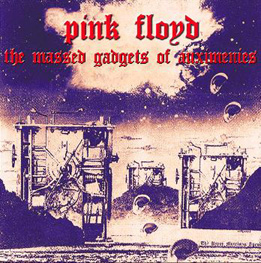 The Massed Gadgets of Auximenes (Harvested CDR 009) |
Harvested Records' The Massed Gadgets of Auximenes is one such recording, though after much research and debate it is believed to be the correct date. Some of the songs performed on this date would carry over to future performances; and some were eventually dropped, as I will soon explain. As you may know, "The Man" section is the first half of this performance, which dealt with a man's daily life. The second half, "The Journey", dealt with a man's adventures.
"The Man" section of the suite started out with "Daybreak", which is found on Ummagumma under the title "Grantchester Meadows". This song is the early morning of a man's day. It starts out with beautiful acoustic guitar and piano with Roger Waters singing. It segued into "Work", which contained series of rhythmic sounds of power tools and carpentry tools working together to represent a man working throughout the day. The song runs just over eight minutes. The working tools slowly faded into "Afternoon", which is a recycled "Biding My Time". This number represent a man's resting in an afternoon. The vocals are sometimes barely audible in this song.
Up next was a Nick Mason drum solo called "Doing It". The meaning of the song in a man's day is pretty self-explanatory. Some performances have the drum solo based on "The Grand Vizier's Garden Party (Part 2)", but this particular performance has the drum solo based on "Up The Khyber", from the More album. It ends just when "Sleeping" comes in. Breathing sounds can be heard to represent a man's sleeping, as an instrumental piece known as called "Quicksilver" on the More album, played. Later performances of The Man and The Journey included a tune called "Nightmare", which was originally known as "Cymbaline", to end the "Man" section. In this performance, "Nightmare" didn't yet exist yet, so the suite ended with the "Daybreak" reprisal.
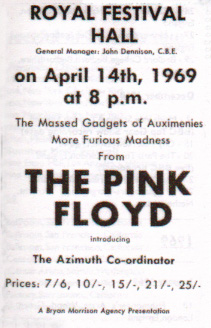 |
"The Journey" suite started with sound effects of waves crashing on shore. The song is "The Beginning", which was originally "Green Is The Colour". David Gilmour's guitar playing and vocals, in my opinion, are quite beautiful. The song quickly faded into "Beset By Creatures Of The Deep", which is a reworked version of "Careful With That Axe, Eugene". The next song is "The Narrow Way", which is part three of the song by the same title from the Ummagumma album.
"The Pink Jungle" is actually "Pow R. Toc H." from The Piper At The Gates Of Dawn, with Roger Waters screaming and cackling in tune of the song. "The Labyrinths of Auximenes" contained a series of sound effects and instrumental music. The song ends with the Walking Sequence, which contained sound effects of a man walking to a door, opening and closing it, and walking some more. The Walking Sequence can be heard in the middle section of "Cymbaline" in later performances. "Behold the Temple of Light" is a beautiful song with all members of the band contributing musically, that fades into "The End of the Beginning", which is actually the "Celestial Voices" section of "A Saucerful Of Secrets". "The End of the Beginning" started out with Rick Wright's powerful keyboards as the rest of the instruments joined in. The encore and show ender was "Interstellar Overdrive", which was not performed as part of "The Man and The Journey" suite.
The sound quality of this recording is not really that bad considering the date of the performance. There are some moments on the disc that are barely audible, and others that are beautiful and clear moments. Regardless of what some people may say about the sound quality, this is quite a historical show. I, for one, enjoy taking it out and listening to it once in a while.
Witness the man who raves at The Wall
A Floyd tribute band undertakes a full-scale re-creation of Waters' masterpiece
At about 2:30 on a sunny Sunday afternoon, a small group gathers along a mostly-deserted street. There are about a dozen people there when I arrive, but the numbers keep growing. Here, a family of four. There, a pair of 30-somethings wonders aloud whether beer will be served inside. Off to one side are three young teens, looking at once sullen and mischievous. Though he was probably in diapers the last time Pink Floyd toured, one is wearing a Wall t-shirt. A couple in their mid-60s arrives, looking a bit sheepish and somewhat out-of-place, with someone's grandmother in tow. When Pink Floyd last toured, she was already collecting Social Security.
We are waiting to watch a full performance of Pink Floyd's The Wall by Dallas-based tribute band Bricks in the Wall.
"You're damned if you do, and damned if you don't" should be the motto for all tribute bands. They can't win; fans will be disappointed if they don't recreate the sound and atmosphere of the original band well enough, but if they are too faithful to the original, you might as well be at home listening to your old vinyl collection.
Nonetheless, tribute bands are becoming increasingly popular. Perhaps it is the tendency of so many current major acts to rely upon slick production and overblown visuals to compensate for their woeful inadequacies as musicians and performers. Or perhaps it is the fact that so many great bands of the past no longer have the energy or the desire to tour endlessly, leaving new generations of fans longing for the opportunity to classic acts in concert.
Several years ago, amateur guitarist Travis Satterfield decided to try his hand at the tribute band game. He had never been in any other bands, and had basically gotten interested in playing guitar because he wanted to learn how to play Floyd music. He took out an ad in a Dallas-area weekly entertainment newspaper, in hopes of finding some like-minded musicians. Among the first to respond was keyboardist Todd Guinn, who was also a serious Floyd fan. They recruited a few others, and met at Guinn's house to jam. A few false starts aside, things clicked, and Bricks in the Wall was born.
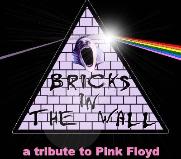 |
Bricks in the Wall performs about twice a month in a variety of venues around the Dallas-Fort Worth area, sometimes taking the show on the road to Austin, Tyler (Texas), and Ardmore (Oklahoma). They incorporate psychedelic projections (using computer-generated animation instead of liquid oil slide) and films into their show, and strive for an authentic recreation of the Pink Floyd concert experience. Their band is composed of two guitarists, two keyboardists, bass and drums, a saxophone player, and two female backing vocalists.
This lineup allows Bricks in the Wall to perform most of the Floyd's repertoire pretty easily, especially the classic Floyd sound of the mid- to late-1970s. Says Satterfield, "Floyd layered so many parts on their albums there is no way to properly pull it off with one guitar or keyboard. I don't think having all of this [including the backing vocalists and saxophonist] necessarily steers us to the later material. Floyd was layering multiple tracks on their albums before Dark Side. There are multiple guitars and keyboards on most of the albums anyway."
That said, the band's typical setlist is heavy on tunes from Dark Side, Wish You Were Here, and The Wall. They have explored the post-Waters material on occasion, and their version of "Set the Controls for the Heart of the Sun" features an extended bellydance by one of the ladies. Both Satterfield and Guinn express interest in performing even more early material, such as "Astronomy Domine" and "Careful With That Axe, Eugene". But as Guinn says, "We have worked up some of the early stuff, but it tends to leave several people with nothing to do."
And then there is the question of keeping the audiences happy. Like it or not, most audiences at a Floyd tribute show are going to be much more interested in hearing "Money" or "Run Like Hell" than a 20-minute rendition of "The Embryo", or even "On the Turning Away".
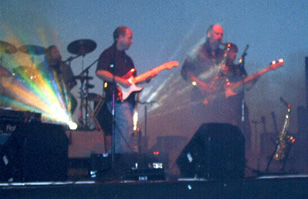 Lights and films help Bricks in the Wall recreate the Floyd experience. (photo from a performance at the Tivoli Theater in Adrmore, Oklahoma) |
Like the Floyd, Bricks in the Wall enjoys putting on a good spectacle. When the Floyd released Echoes: The Best of Pink Floyd in 2001, the band did a special performance of Dark Side of the Moon at a CD release party. And then about a year ago, Satterfield hit upon the idea of recreating the Floyd's legendary Wall shows. They had played shows at Fort Worth's Ridglea Theatre, a converted cinema that hosts many local bands as well as touring acts looking for an intimate setting. The Ridglea's owners happen to be great Floyd fans, and when the band started talking about the concept, light bulbs started going off, says Guinn.
The Ridglea Theater sponsors a small theater company, called the Box Theater, which performs everything from Shakespeare's King Lear to original plays by Michael Johnson, the company's director. Early on in the planning for the Wall shows, the Ridglea's owners suggested getting the Box Theater involved, to act out some of the story alongside the music. It was an idea that appealed to both the band and the actors. "I believe that if Roger had it to do all over, he may have done it more like this," says Satterfield, "using actors and such. Not so much band involvement."
As plans developed, the band looked for ways to reinvent some of the Floyd's famous staging. "We actually had a plan to build a gigantic teacher," says Satterfield. "But we just ran out of time." "Initially, my idea was to do it exactly like the original Wall show: lots of animation from the movie, and have the whole band come out in front '"In the Flesh' through 'Waiting for the Worms'. But we just couldn't pull it off due to logistics. It would have required two of everything, and re-micing out front. It just would have been too difficult. So we scrapped that idea and just had the Box Theater stage that."
The band gave director Michael Johnson free rein over the actors, although they were allowed to make some suggestions about the costumes and such. Johnson was given a copy of the Is There Anybody Out There live release, and was told that the band would be following the live performance pretty closely (including the performance of "What Shall We Do Now?", extra organ solos in "Another Brick in the Wall, part 2" and "Young Lust", and the extra verse in "The Show Must Go On"). Johnson did request that a few songs be lengthened by a few measures here and there, to accommodate the actors' entrances and changes of scenery. Kids from local schools were recruited to perform "Another Brick in the Wall, part 2", and a high school drama department provided extras for the fascist rally scenes on side 4.
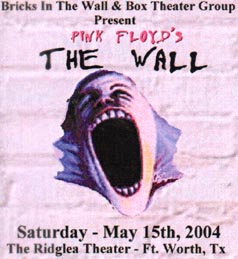 |
In the weeks leading up to the May 15-16 performances, the band did as much as they could to promote the shows. A local classic rock radio station ran some promo spots, and the morning DJs talked up the performance. An AM sports talk station gave away tickets to the show on the air.
But for the most part, it seemed that the local media outlets weren't sure what to make of this ambitious endeavor. A columnist in the Dallas Observer (that same weekly newspaper that had played such an important role in the band's genesis) seemed genuinely surprised that anyone (especially families with children) could enjoy The Wall without being stoned. The Fort Worth Star-Telegram's pre-performance article began by saying that the show would "either be very cool or very comical". In fact, the band itself was a little nervous about the public response, and though a Sunday matinee had been scheduled to follow the Saturday night debut, they weren't certain they were going to go through with it.
But Saturday night's show changed all that. The Ridglea was packed to overflowing. Some 700 people made it in the doors, and between 200 and 300 were turned away. Guinn said, "Saturday night's show was by far the most magical crowd we have ever played for." The audience roared, and cheered, and swayed, cigarette lighters held aloft. There was no doubt about the demand for a Sunday show, which had an audience of about 100.
Upon entering the theater, the audience was greeted by the music of Vera Lynn, including well-known songs such as "When You Wish Upon a Star" and "We'll Meet Again". The band's equipment took up the entire stage, but there was a large area in front of the stage that was clear of chairs, which is where the actors did their performance. I couldn't help notice that there was no room onstage for a wall to be built, and couldn't help but feel a little let down.
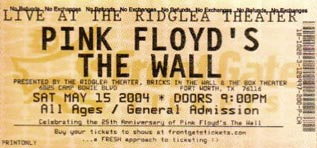 |
Eventually, Michael Johnson came out and introduced himself, and made some announcements requesting that there be no flash photography... and no fireworks. The performance had begun. "I think the band is about ready to start... no... no... not quite yet."
The last time I saw Bricks in the Wall I had been much more impressed by their handling of the Wall material than anything else in the repertoire, so I knew that the music would be solid. They certainly did not disappoint on that score. "In the Flesh?" was tight (and, from my seat just in front of the soundboard, loud). "The Thin Ice" saw the first appearance of the actors, as a small (blond!) boy representing Pink sat in the center of the stage area and played with some toys on the floor. His mother watched him lovingly from a distance, and I was surprised when his father sat on the floor beside him and joined him in his games.
As the song faded into "Another Brick in the Wall, part 1", a man delivered a letter to young Pink's mother, who looked it over and reluctantly handed it to Pink's father. He stood, read it over, hugged his wife, and then solemnly began dressing in a military dress uniform as Pink watched frozen in his place. The father then approached the boy, hugged him warmly, and waved goodbye to mother and child. He then walked over to the stack of large white boxes (which I swear I hadn't really noticed until this point), took one, and slowly made his way to the bandstand and placed the first brick in Pink's wall at the center of the stage.
Wow. Such symbolism. It was at that moment that I knew without a doubt that I was in for something really special. I knew that the director of this show really understood what The Wall is about. And watching the father being taken away from his family by two masked figures (representing death and war, I believe) made the reality of young Pink's loss all the more real to me.
During "The Happiest Days of Our Lives" and "Another Brick in the Wall, part 2", Pink was joined onstage by a dozen schoolchildren in uniforms who played games for a few minutes, and then were herded into a formation by 4 or 5 maniacal teachers. After berating Pink and the other children, the teachers each took a brick from the pile and added it to the wall onstage. The children sang their chorus, and then erupted into a frenzy, swarming over the headmaster and carrying him offstage.
Throughout the performance, the actors continued to bring the story alive. It was chilling to see Pink cuddled by his mother, who was now wearing a mask that turned her face into a yonic symbol of which Gerald Scarfe himself would have been proud. Later, a gaggle of groupies seduced the concert security guards--much to the chagrin, I am told, of some of the mothers of the children in the chorus. One groupie escorted the mature Pink backstage, where he threw her around, smashed a guitar, overturned a TV set and table, and chased her off. (There was one unintentionally funny moment when we heard the familiar line, "Are all these your guitars?", and the groupie motioned toward the lone guitar propped up against the stage.)
During "Don't Leave Me Now" we saw Pink's wife and her lover (who had been identified to us earlier) engaging in very convincing simulated sex right on stage, as Pink hovered over them, glowering fiercely. (At the performance I attended, there were five or six teenaged boys who took an intense interest in this scene, which took place just a few feet from their seats. Meanwhile, a few rows back, there was a very young girl sitting with her parents who had apparently been instructed to cover her eyes during certain parts, and she obeyed dutifully.)
Familiar animated sequences were projected behind the band during "Goodbye Blue Sky" and "What Shall We Do Now". And all the while, a single stage hand was gradually adding bricks to the wall, leaving a few gaps here and there. As the intensity built during "Another Brick, part 3" and the "Last Few Bricks" instrumental, Pink--looking quite haggard--found himself surrounded onstage by a haunting collection of characters from his past: his wife and her lover, the groupies, the schoolchildren, the teachers, and his mother. Then the masked figures of death and war brought in the lifeless body of Pink's father, and dropped it at his feet.
Overcome with emotion, Pink fell to the ground and cried, and the crowd drew in closer around him. In another stunning bit of dramatic symbolism, the entire group picked up Pink and passed him through a small gap in the wall, then turned en masse and quickly finished putting the remaining bricks in place, walling Pink in. As "Goodbye Cruel World" played, we saw Pink staring out from the last hole in the wall, a spotlight framing him. As the song finished, he placed the final brick in the wall.
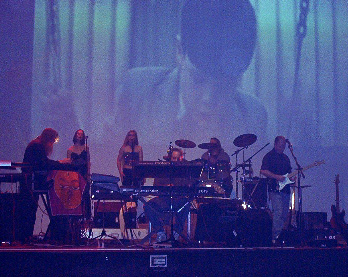 Material from The Wall makes a regular appearance in Bricks in the Wall's regular setlist. (photo from a performance at the Tivoli Theater in Adrmore, Oklahoma) |
After a brief intermission, "Hey You" was accompanied by some computer-generated psychedelic swirls and such. While this did provide something to look at besides the blank wall, it sadly neither enhanced the experience nor added to the storytelling. Through the next few songs, Pink appeared in front of the wall, sitting in his chair and staring at the television in a psychotic catatonia reminiscent of Bob Geldof's performance in the Wall film.
In "Comfortably Numb", a doctor wearing another eery mask appeared and attempted to rouse Pink, finally resorting to jabbing him with a large hypodermic needle. During the final extended guitar solo, Pink rose from his chair and stared out at the audience with a creepy and genuinely frightening, crazed look in his eyes, while more psychedelic swirls were projected across his face and onto the wall behind him, this time to much greater effect. He eventually straightened, put on a black shirt and military cap (his Hammer uniform) and a faceless mask reminiscent of the Pink doll from the film and original concerts. His transformation into a faceless, unthinking fascist 'worm' was complete.
The band, in addition to the faithful recreation of the music, also managed to recreate one of rock's great guitar hero moments. During the original Wall concerts, David Gilmour performed his choruses and guitar solos from atop the massive wall. The Ridglea's Wall was only about 12 feet high and 30 feet wide, but still it seemed unlikely that they would be able to get anyone on top of it.
Travis Satterfield said, "I originally wanted to rent a lift for Gunter [Heydman, the guitarist who handled the solo in "Comfortably Numb"], but there wasn't enough room and the lift was huge. So I kind of shelved the idea. We didn't even try that on our final rehearsal with the cast. On Saturday when we were doing set up and sound check I told someone to get a ladder and have Gunter climb up and see if he would clear the wall, and also make sure it was stable so he wouldn't fall. So the show was the first attempt. We had two people behind Gunter in case he got off balance."
It paid off. Heydman's solos were dramatic and beautiful, even we could only see him from the waist up. One of the stage lights was positioned to cast his shadow upon the theater's wall behind him, and it really worked. Coupled with the action on floor below him, there was no lack of impressive visuals. Roger Waters would have been proud.
As mentioned previously, the production did not attempt to bring a surrogate band out in front of the wall for the last few songs. Instead, the Box Theater company acted out Pink's fascist rally. In a way, this worked very well. It provided a certain continuity with the actors that had already been part of the performance, and it allowed the band to be a little more faithful to Waters' original concept for the project: build a wall between the band and the audience, and perform the second half entirely hidden by it.
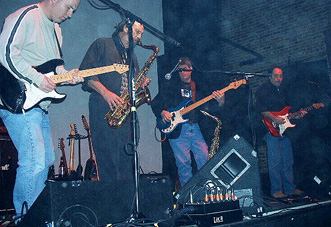 (photo from a performance at the Tivoli Theater in Adrmore, Oklahoma) |
After Michael Johnson reprised his M.C. speech at half-speed, a group of Hammer Guards came out and flanked the masked Pink, who stood behind a lectern. When he pointed out the assorted 'riff-raff' in the audience, the guards grabbed people out of the audience, threw hoods over their heads, and forced them to kneel onstage. In light of the recent images of American soldiers torturing Iraqi prisoners, it was quite gripping. Once again, the presence of live actors brought the entire spectacle to life in ways that seemed both fresh and disturbingly familiar.
During "Run Like Hell" the guards began beating their prisoners, and a horde of actors, clad in black shirts bearing the familiar hammer emblem, led a procession into the audience and up and down the aisles, waiving their giant hammer banners. "Hammer! Hammer!" they chanted, and they cheered as Pink raised his megaphone and spurred them on to a little ethnic cleansing during "Waiting for the Worms". It was quite a dizzying sight: banners waving, followers chanting (including teens--which made it all the more shocking), Pink jumping about and shouting, and the animated hammers marching across the wall again and again and again.
"The Trial" was performed entirely live on synthesizers by Bricks in the Wall's two keyboardists, and they did an amazing job recreating the sound of an entire orchestra. The actors pantomimed the roles of the judge, barrister, schoolmaster, wife, and mother, all wearing various masks, with Pink standing before them in judgment. During the choruses ("Crazy... over the rainbow"), the fascist followers--still standing in the aisles amongst the audience--sang along, to further chilling effect. And when the sentence was pronounced, the whole cast (and much of the audience) joined in shouting "Tear down the wall!" until the band did indeed knock it all down before our eyes.
It was a moving performance, from start to finish, far surpassing my expectations. Satterfield had promised the Dallas Observer, ""This isn't going to be some thrown-together community theater affair," and the band and actors and crew delivered. The post-show feedback has been overwhelmingly positive. As I mingled with the band and the cast after the performance, Guinn and Satterfield made sure everyone involved signed one of the cardboard bricks, but kept the rest of them intact... just in case they perform The Wall again.
"I really enjoyed performing The Wall," said Satterfield. "We will do it again, and hopefully in different cities. We are talking about how to take the show on the road, and will probably be back at the Ridglea in three or four months with it."
"Tons of people love Pink Floyd, but if you weren't lucky enough to see them in the past, then you're probably out of luck. I would really love to see them live again, and especially with Waters, but I don't think it's going to happen. Gilmour doesn't seem to be in any hurry to tour again. So the only way you get to hear the music live at all is through tribute bands. The Wall is 25 years old now, and there are tons and tons of younger fans that are starting to get into Floyd and seen the movie, but have never seen Floyd. I get parents coming up to me all the time after shows with their kids, telling me how they saw Floyd but their kids never have, and they want to at least let them hear the music live, even if it isn't by the actual band. Why do they sell about a million copies a year of Dark Side of the Moon? Kids are getting turned on to the music everyday."